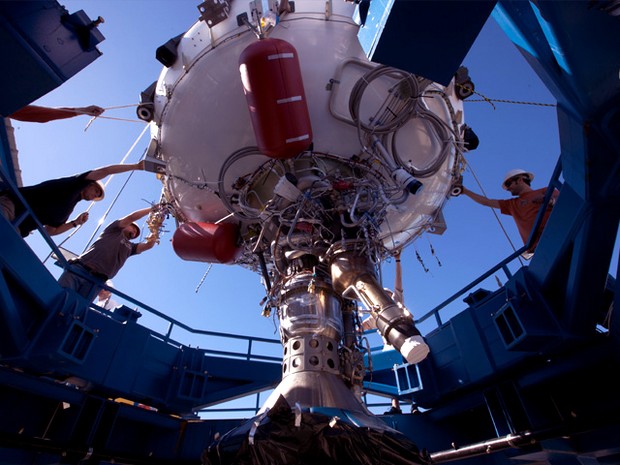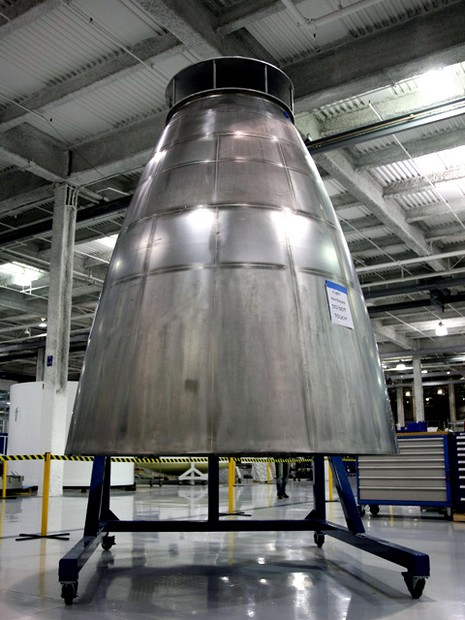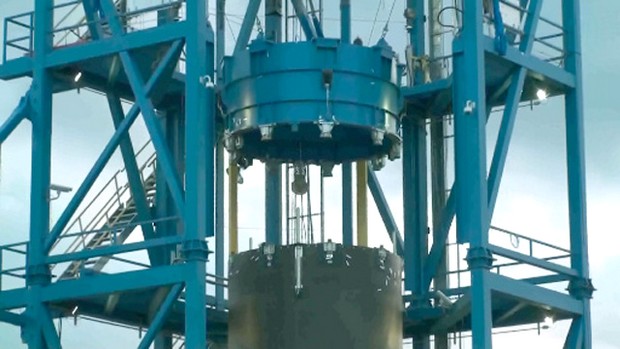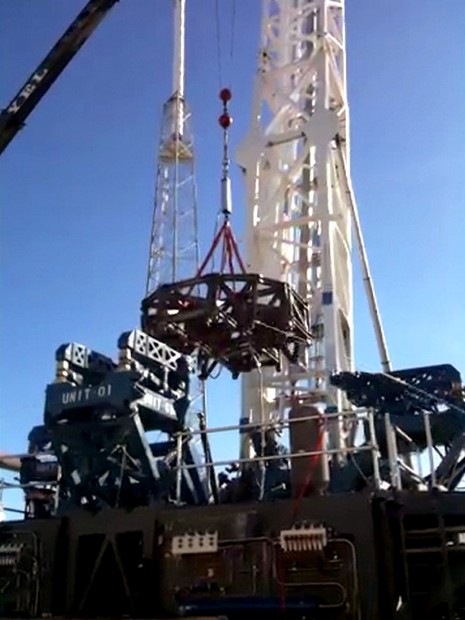 Falcon 9 vertical test at Cape Canaveral
Falcon 9 vertical test at Cape Canaveral
IPFS
Falcon 9 second stage testing successfully completed
Written by Powell Gammill Subject: Space Travel and Exploration
The SpaceX team kicked off 2010 with the successful full duration orbit insertion firing of the Falcon 9 second stage at our Texas test site (details below). This was the final stage firing required for launch, so the second stage will soon be packaged for shipment and should arrive at Cape Canaveral by end of month. Depending on how well full vehicle integration goes, launch should occur one to three months later.
2009 was an exciting year for SpaceX. In July, with the successful launch of RazakSAT, Falcon 1 became the first privately developed liquid fuel rocket to put a commercial satellite in orbit. That same month, DragonEye--SpaceX's Laser Imaging Detection and Ranging (LIDAR) sensor--launched on NASA's STS-127 shuttle mission and successfully completed flight system trials in preparation for guiding the Dragon spacecraft as it approaches the International Space Station. We also hosted the first astronaut training day at our Hawthorne headquarters in preparation for flights to the Space Station.
Last year also saw the successful arc jet testing of PICA-X, SpaceX's high performance heat shield material developed in collaboration with NASA, which will be used to protect our Dragon spacecraft on reentry. And our Merlin Vacuum engine demonstrated the highest efficiency ever for an American hydrocarbon rocket engine. SpaceX also signed deals with several key customers, including CONAE (Argentina's National Commission on Space Activity), Astrium and Orbcomm.
The ongoing evolution of the commercial space industry was recently featured as the cover story ("The New Space Rush") in Popular Science magazine. The article provided a great perspective on the industry as a whole, but I disagree with the subheading, "Who Needs NASA?". If you read the article, it's clear their intent was just to convey excitement for the developments in commercial space, but obviously NASA is and always will be critical to the future of space exploration, particularly at the outer edge where there is no commercial market. Without NASA, SpaceX certainly would not be where it is today.
As we get closer to our first Falcon 9 launch, SpaceX would like to thank NASA, the Air Force, the FAA and our commercial customers for their continued support. And, of course, I would like to thank the whole SpaceX team for their unwavering commitment to our company and our mission, especially over these last few months. Through their hard work and dedication, 2010 promises to be another great year.
--Elon--
Falcon 9 First Stage
Prior to arrival at the Cape, the Falcon 9 first stage arrived at our Texas Test Site. There, we did a full checkout, raised it up to the top of the 72 meter (235 foot) tall test stand, and conducted two successful nine engine test firings – the first 10 seconds long, followed by a 30 second long firing three days later.

Test firing video (click on image) of the full flight first stage of Falcon 9, conducted Oct 16, 2009 at the SpaceX Texas Test Facility in McGregor. Click to play video, and note the engines gimballing (steering) in the upper left camera.
Everything performed as planned; we then shipped the first stage to Florida and have commenced final processing in the hangar at the SpaceX launch site. Once all propulsion and avionics checkout processes are complete, we will move forward with stage mate, to be followed closely by vehicle transfer to the transporter erector, and a static fire shortly thereafter.

Falcon 9 Second Stage
Flight hardware for the Falcon 9 second stage also shipped to Texas, where it completed static load testing, and then was integrated with the previously tested Merlin Vacuum second stage engine. After performing system checkouts, we raised the stage up on to the newly completed Upper Stage test stand.

Installing the Falcon 9 second stage into the newest test stand at our Texas test site. Photo credit: Chris Thompson, SpaceX.
In November we conducted the initial second stage test firing lasting forty seconds. This test involved a new test stand, a new flight stage, and it occurred as planned, on the first attempt without aborts or recycles.

First test firing of the full flight second stage of Falcon 9, conducted at the SpaceX Texas Test Facility in McGregor. Photo credit: SpaceX
On January 2, 2010, the team completed a full duration orbit insertion firing (329 seconds) of the integrated Falcon 9 second stage. At full power, the Merlin Vacuum engine generates 411,000 N (92,500 lbs force) of thrust, and operates with the highest performance ever for an American-made hydrocarbon rocket engine.

Full duration orbit insertion firing of the Falcon 9 second stage, conducted on January 2, 2010. Click on image to play video.
Having multiple stands for testing individual engines, first and second stages, and Draco thrusters allows us great freedom in processing hardware for flight. Our manifest currently lists more than twenty-five Falcon 1e and Falcon 9 missions, seventeen of those with Dragon spacecraft, so all of our stands will be kept very active.
Merlin Vacuum Engine Expansion Nozzle

Interstage
The interstage physically joins the first and second stages, and houses the Merlin Vacuum engine during first stage ascent. The carbon composite cylinder measures 3.6 meters (12 feet) in diameter and nearly 8 m (26 ft) tall.
The top edge of the interstage contains a set of clamping collets that join the first and second stages during liftoff and ascent. After the first stage shuts down, the collets release, and three pneumatic pushers smoothly and forcefully separate the stages, clearing the second stage engine for ignition.
This stage separation system resembles a larger version of the one successfully used on our Falcon 1 vehicle. Note that this system uses no explosives, making it safer to assemble and deploy, and increasing its overall reliability, as we can conduct multiple tests of every flight component, whereas an individual explosive device carries the risk of being fully testable only once – in actual use.

Dragon Qualification Spacecraft
The inaugural Falcon 9 flight will loft our Dragon qualification spacecraft into orbit. After completing testing in Texas, the Dragon spacecraft shipped to the Cape in preparation for first flight.

First flight Dragon nosecone (tan, at left), spacecraft (middle) and trunk (right) in process at the SLC-40 launch pad hangar in Florida. Photo credit: SpaceX.
In preparation for flight, the Dragon spacecraft was mated to the trunk (see below), which in future flights will house both unpressurized payloads and the vehicle's solar panels. By flying the Dragon spacecraft configuration, we will obtain valuable data about its performance during the climb to orbit, which will support the following Falcon 9 flight – the first launch under the NASA Commercial Orbital Transportation Services (COTS) program. On that flight, an operational Dragon spacecraft will make several orbit of the Earth, followed by reentry and splashdown in the Pacific Ocean off the coast of California.

Pressurized portion of the Dragon spacecraft, top, mated to the cylindrical unpressurized trunk section below. As Dragon has been designed from the start for human transport, even the cargo and demonstration versions include windows (circle at top, covered for protection during painting). Photo credit: SpaceX.
Launch Operations - Cape Canaveral SLC-40
As the flight hardware converges on Florida, many significant activities continue around our launch site in preparation for first flight.
Launch MountAs with our Falcon 1 rocket, the Falcon 9 uses a "hold before launch" system where the launch mount firmly restrains the rocket as it develops full thrust. Once engine performance is verified, the rocket commands the launch mount to set it free.
The Falcon 9's four-part launch mount assembly performs several significant tasks. At rest, it supports the fully fueled Falcon 9, with a mass of over 330,000 kilograms (nearly three-quarters of a million pounds). Next, as the first stage's nine Merlin engines fire and reach full power of nearly 5 MN (over 1 million pounds force), the mounts must hold the vehicle down against the upward thrust.
Finally, upon command, the mounts release the rocket and then move out of the way, giving the nine engines maximum clearance as they lift the vehicle away from Earth.
Months of construction and testing converged into a series of final tests of the launch mount system. The four mount towers were attached to the base of the Transporter / Erector, and their hydraulically powered actuators checked to verify performance.
Recovery Preparations
Both the Falcon 9 first stage and Dragon spacecraft are designed to be recovered. For this first demonstration flight, the Dragon spacecraft will remain in orbit but our team will attempt recovery of the Falcon 9 first stage and has commenced with recovery testing operations (see photo below).
Recovery Preparations
 Flotation
testing of a portion of the recovery raft that will aid in returning
the Falcon 9 first stage to land after flight. Photo credit: SpaceX.
Flotation
testing of a portion of the recovery raft that will aid in returning
the Falcon 9 first stage to land after flight. Photo credit: SpaceX.Other progress at SLC-40 includes:
- Nearing completion of a new hydraulic system to provide pressurized RP-1 propellant in support of hangar and pad checkout of vehicle Thrust Vector Control (TVC) systems.
- Nearing completion of new gaseous nitrogen system (used for pressurization, line purges, etc.), and a new helium system (used for vehicle pressurization, cooling and engine startup).
- Completion of the liquid nitrogen delivery system and final fill of 4,900 gallons to the site's storage tank.
- Installing new Payload Environmental Control System on the pad to keep future cargo loads comfortable during processing and preparation for launch.
- Functional testing of the new helium fill system. During loading, we chill the Falcon 9's helium storage tanks down to minus 184 degrees C (minus 300 degrees F).

- Multiple test deployments of the Transporter / Erector system (shown above), and the addition of vehicle fill and drain plumbing and umbilical support systems.
- Completed installation of a new dual-redundant, fault tolerant digital information network in support of mission operations and launch pad systems.
- Flow tests verifying the systems that will apply large amounts of water to the launch pad to provide noise and fire suppression during liftoff.
Mission Operations
Radio Tests
Back at our Hawthorne, California headquarters in mid-October we conducted a complete end-to-end test of our Dragon radio communications system with the NASA geosynchronous Tracking and Data Relay Satellite System (TDRSS).

The SpaceX communications flight hardware, developed with subcontractors Delta Microwave (Low Noise Amplifier), Quasonix (transmitter and receiver), and Haigh-Farr (antennas), emulated a complete Dragon spacecraft comm link, and successfully sent and received data through the TDRSS network. Commands were dispatched from our Hawthorne headquarters command station, to NASA JSC in Houston, across Texas to the TDRSS White Sands Ground Terminal, up to the TDRS 5 Spacecraft in geosynchronous orbit, and back down to the Dragon receiver on the ground in Hawthorne.
The test series demonstrated telemetry and command transmission at a variety of data rates up to 2.1 Mbps, and paves the way for using TDRSS on all fifteen of our Dragon missions for the COTS and Commercial Resupply Services (CRS) programs.
COTS Flight 2 RehearsalsAlso in Hawthorne, we recently completed a very successful joint mission simulation with NASA's Mission Operations Directorate where the team rehearsed the operations that will be conducted during the second COTS flight (the third Falcon 9 launch).
 Computer illustration showing a Dragon spacecraft approaching the ISS. Image credit: SpaceX.
Computer illustration showing a Dragon spacecraft approaching the ISS. Image credit: SpaceX.These tests help us progress towards the day when SpaceX will begin a series of twelve CRS cargo delivery missions for NASA to support the continued operation of the ISS.


























